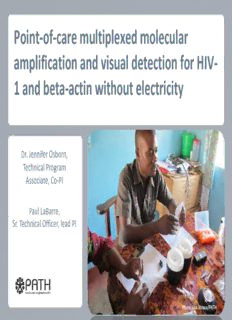
Point of Care multiplexed molecular amplification and visual detection for HIV-1 adn beta-actin ... PDF
Preview Point of Care multiplexed molecular amplification and visual detection for HIV-1 adn beta-actin ...
Point-of-care multiplexed molecular amplification and visual detection for HIV- 1 and beta-actin without electricity Dr. Jennifer Osborn, Technical Program Associate, Co-PI Paul LaBarre, Sr. Technical Officer, lead PI Photo: Lisa Stroux/PATH Problem: Lack of Appropriate Diagnostic Tests Decentralized Low-Resource Laboratory Centralized PCR Laboratory http://www.science.leidenuniv.nl/index.php/ibl/dna_markerpoint/view_inside Photo: PATH Page 2 4/8/2013 Point-of-care Testing in Low-resource Settings Types of tests: Test settings Test users: Hospital • Hospital staff, • RDT, molecular smears lab tech Peripheral • RDT, PCR, ELISA, • Lab tech Lab microscopy Clinic or Health • RDT, • Clinical staff Post handheld instruments • Minimally trained Community • RDT health worker • RDT Home • Lay person Pag e 3 4/8/2013 Molecular Diagnostics Technology Requirements WHO Polymerase Chain Decentralized Low-Resource Diagnostic Ideal POC Test Reaction Laboratory Criteria Centralized PCR Laboratory High cost Affordable Low cost Highly sensitive Sensitive Highly sensitive Highly specific Specific Highly specific Technically trained Minimal user steps User friendly users required required Rapid & Days to months Minutes to hours robust Power and equipment Equipment No power required, no required free complex equipment Deliverable to http://www.science.leidenuniv.nl/index.php/ibl/dna_markerpoint/vie Not portable, Highly portable, dried w_inside developing refrigeration required reagents Photo: PATH countries Point-of-care molecular diagnostics could reduce the disease burden • Page 4 4/8/2013 Early Infant Diagnosis and Linkage to Care is Critical 370,000 new HIV infections from mother-to-child • transmission (UNICEF, 2008) EID improves health • outcomes CHER trial in South Africa: • 76% reduction in • morbidity 75% reduction in • mortality Photo: March of Dimes Challenges with Current Tests : Available tests • rapid diagnostic tests (RDTs) • PCR for infant testing with dried blood spots • ~60% of infants are lost to follow-up • Only 6-15% of HIV-exposed infants accessed testing • (WHO, 2009) Maternal antibody interference Centralized laboratories Photo: PATH Photo: CDC Defining Use Cases and Target Product Profiles (TPPs) Exploratory Stakeholder Interviews Technical Use Case(s) TPP(s) Specifications User Needs Assessments Alpha Prototype Design Iterations NIH RO1 Target product profile process helps to ensure • technologies will meeting existing needs PATH’s Approach: A Non-Instrumented Nucleic Acid (NINA) Diagnostic Platform Exothermic Isothermal Nucleic Point-of-Care NINA Heat A cid Amplification Heater Device PCR Tubes www.ontech.com PCM Curtis et al. J. Med. Virol. Photo: PATH 81:966–972 (2009) MgFe/H2O Reaction Isothermal amplification simplifies the power • requirements for amplification Page 8 4/8/2013 Benefits of NINA Compared to PCR Testing Gold WHO NINA Standard: Diagnostic Heater + PCR Criteria LFD Centralized PCR High cost Affordable Low cost Point-of-Care Laboratory NINA Heater Highly sensitive Sensitive Sensitive Highly specific Specific Specific Technically Minimal User trained users User friendly Steps required Days to months Rapid & robust ~60-90 minutes Power and No power or Equipment complex complex free equipment equipment Photo: PATH Not portable, Deliverable to Photo: Highly portable, http://www.science.leidenuniv.nl/index.php/ibl/dna_markerp refrigeration developing oint/view_inside dried reagents required countries The NINA heater is designed for nucleic acid detection in low- resource settings for improved acute and infant HIV diagnosis. Page 9 4/8/2013 NINA Kit concept User-friendly Operation of the NINA Heater
Description: